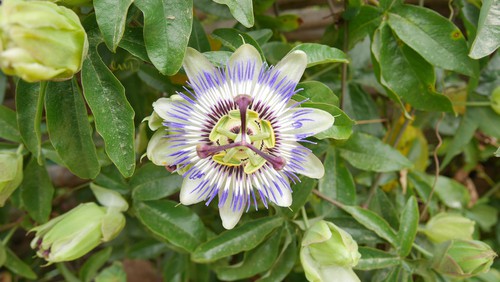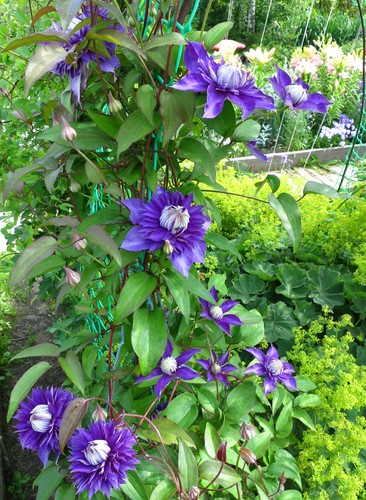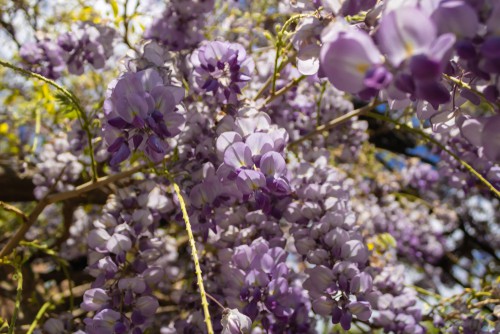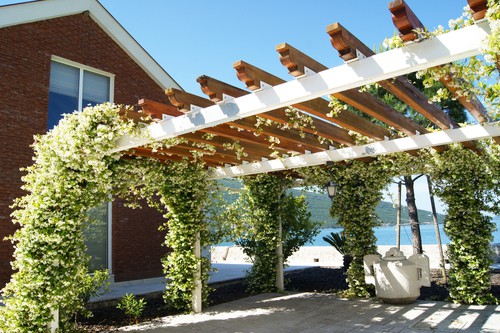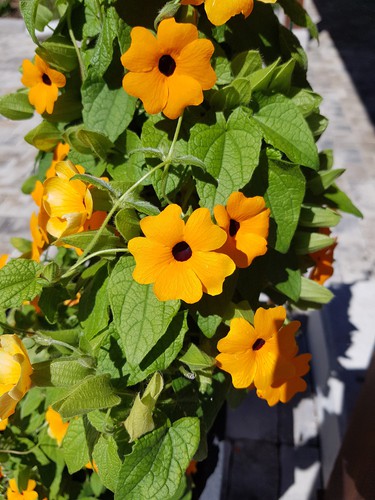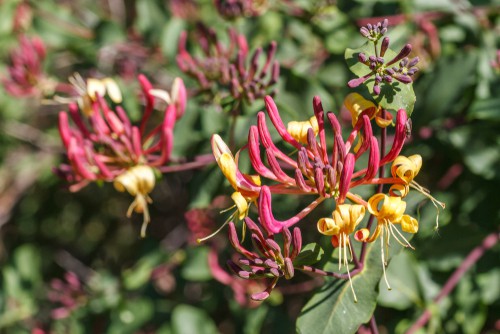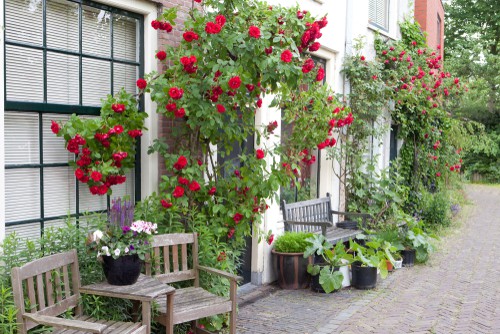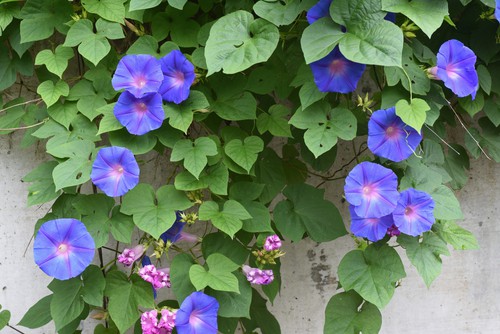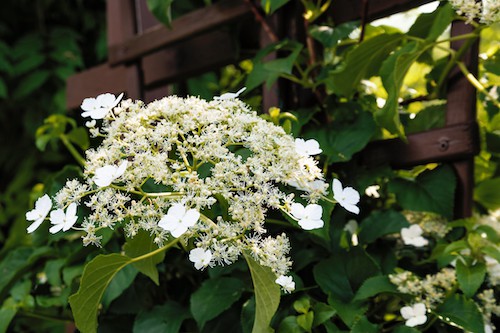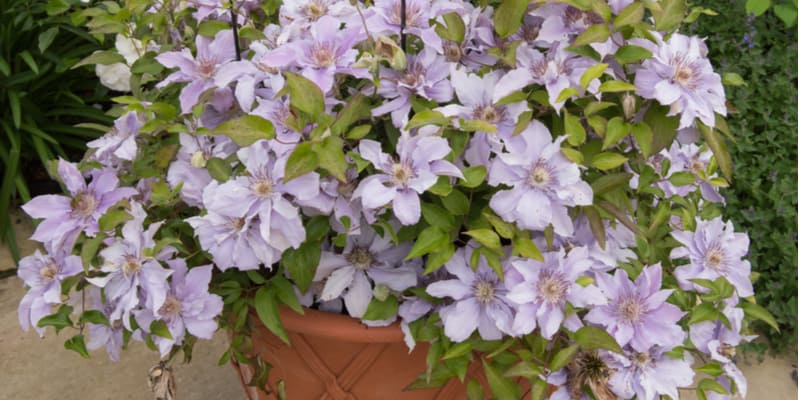
Top 10 Best Climbers for Pots & Containers
Our site is reader supported, this means we may earn a small commission from Amazon and other affiliates when you buy through links on our site.
Many climbing plants are some of the easiest plants to grow and can be ornamental, making them ideal for patios, balconies, and terrace gardens. Planting climbers in pots and containers is the easiest way to integrate these plants into your space, whether indoors or outdoors.
Gardeners interested in potting climbers have many options available, whether they prefer blooming or non-blooming varieties. I start off with some of my favourite varieties that grow particularly well in pots, many evergreen offering all year colour even in winter.
1. Passiflora caerulea (Passion Flowers)
Passiflora caerulea commonly known as passion flower is an exotic looking climber with sizable showy flowers, this climber attracts and feeds different pollinators such as birds and butterflies creating a beautiful display from summer to fall.
This plant was popular back in the Victorian era and presently, it has not lost its charm possessing different hybrids to select from. Apart from the conspicuous flowers, some of its species offer edible fruit, such as the Passiflora edulis.
Growing these plants successfully requires well-drained soils teeming with fertility to provide nutrients over several seasons. They can tolerate sunny locations or partly in the shade, but ensure plants sitting under the sun receive enough water.
In winter, provide less water to prevent diseases, and prune in spring to support vigorous growth. While the climbers die down in winter, they may retain their leaves if the weather is not too harsh and in some countries they are even classed as evergreens.
Planting them is not hard, just give it a try and enjoy their showy blooms.
No products found.
2. Clematis
Another showy climber to brighten your space is clematis and its many cultivars. Favourably known as the queen of climbers, this vigorous climbing plant displays beautiful, differently coloured blooms depending on the variety. The mass of attractive blooms manifest from summer to fall because different cultivars have varied flowering times.
Clematis plants whether evergreen or deciduous are easy to grow and maintain. These plants need several hours of sunshine to thrive; therefore, partly shaded or sunny locations are preferable. If the plants do not get enough sun, then blooming is often an issue.
Start growing these plants in spring to give them adequate time to mature before winter begins. Ensure that the soil is moist, well-drained, and fertile to give the plants enough nutrients to thrive. Aside from that, pruning should be conducted annually according to the variety as late bloomers are typically cut back in late winter/ beginning of spring, while early bloomers are pruned after blooming and some varieties will even produce to blooms in one season.
3. Wisteria Amethyst Falls (A smaller growing variety)
Although Wisteria amethyst falls does not display large singular blooms, the small flower clusters are still a sight to behold. The deciduous climber offers an abundance of foliage that contrasts well with the blooms that emerge in spring through to summer. These blooms are attractive and scented, filling your space with a welcoming fragrance.
Wisteria amethyst falls compared to Japanese wisteria grows less vigorously but nonetheless still suitable for potting. The woody climber thrives in areas where the sun is accessible, whether it is partial or full access. You must use well-drained compost that are fertile to give the plant all it needs to flourish. The soil cannot be dry otherwise, you risk the climber wilting, especially if it is not established.
Because the climber tends to get woody, pruning is vital in maintaining its wild growth. Ideally, the plants should be pruned twice annually around August and latest February. This will help the plant produce better blooms and improve circulation to prevent fungal diseases such as powdery mildew. With this plant’s appearance and fragrance, you are sure to attract some pollinators such as bees and birds.
Read next: Best fast growing climbers
4. Jasminum nudiflorum (winter jasmine)
If you are looking for a climber that will bloom during winter, the Jasminum nudiflorum is the one for you. This climber produces small white flowers in winter and spring; however, you will find the foliage missing during winter. The bright yellow flowers on the leaf-bare stems create a unique cascading feature supported by a trellis or an arch.
Preferring well-drained soils, this climbing plant tolerates both partial shade and full sun without affecting the blooms. It is not picky in terms of pH as long as the soil provides adequate nutrients. The low maintenance plants need group-2 pruning, which calls for cutting back the old stems close to the ground.
While the plant is drought-tolerant, watering young plants is crucial to prevent wilting, especially for plants sitting under the sun daily and grown in pots.
5. Trachelospermum jasminoides (star jasmine)
The first thing you notice about Trachelospermum jasminoides is the great abundance of leaves. If you are in search of a bushy climber to cover walls or fences, this evergreen plant is more than suitable. The woody climber is not all foliage, it produces small white blooms in summer before, and berries in fall before the foliage turns a reddish-bronze in winter.
This plant is also identified as Chinese ivy because of its vigorous growth and full coverage but its much less damaging. It prefers sand, loam, or clay soils with proper drainage to avoid devastating diseases like root rot. Plants need sunlight to produce food; therefore, for this plant to flourish, place it in full sun or partial sunlight.
Trachelospermum jasminoides is a low maintenance zone-4 plant that should be pruned at the beginning of spring or late winter to keep it from extending to unwanted areas. Pruning occasionally is adequate, you don’t have to prune twice a year. The bushy climber is typically disease-free, but be on the lookout for cushion scale and spider mites. Make sure to place the plants in a protected area during winter to prevent damage stemming from extreme cold.
6. Thunbergia alata (black-eye susan)
Spotting beautiful, bright orange/yellow blooms, Thunbergia alata is a climbing plant you can use to brighten up spaces with ease. The perennial plant hails from East Africa, but people have managed to grow it around the globe. These brightly coloured blooms appear in summer and autumn looking great contrasted with the dark green foliage.
It is a vigorous climber; thus it is better to provide a supporting structure to prevent them from taking over the floor. It also prefers full sun to maintain the flowers and make food for the plant to reach maximum growth. The herbaceous climber grows in most soils like clay, chalk, and loam with varied pH. Ensure the soil used has good drainage because it makes the plant susceptible to infections if left sitting in waterlogged soils.
The hardy zone-2 plant may suffer from powdery mildew; therefore, prune to facilitate proper ventilation while keeping the foliage dense. You should prune this plant according to group 11 recommendations, which is in early spring or late winter as it blooms on the current growth. Other than that, the plant offers no major challenges, just keep the soil moist, and deal with any pests like spider mites as soon as they appear.
Read next: Best climbers for plants in a shady spot
7. Lonicera periclymenum (Common Honeysuckle)
Common Honeysuckle is next on the list, presenting tubular flowers that produce a distinct fragrant scent. These small summer flowers range in colour from white to yellow insides with purple exteriors. After flowering in summer, tiny red berries emerge in summer, creating another level of visual interest. In winter, the common Honeysuckle loses foliage because they are deciduous plants.
The climber flourishes in different soils, and it can tolerate varied soil pH, thus making it easy to manage. Additionally, the zone-6 plant requires little pruning to stay in shape, especially if you are using it for screen purposes. The plant follows group 11 pruning stipulations that recommend cutting it back after flowering, therefore rejuvenating the plant.
Considering that the plant’s scent is more saturated at night, you can sit near them on those starry summer nights and enjoy the fragrance. Ensure the plant is placed in a location where accessing the sun is possible.
8. Climbing Roses
Roses have secured their reputation in the gardening scene as being amongst the most attractive flowers in the world. All over the UK, you will find that various climbing rose cultivars are thriving with little problems. Climbing roses are low maintenance as long as the soil offers the right conditions, and they have supporting structures.
The ideal soil to grow climbing roses has to be moist but offer good drainage, and that is why it is preferable to use loam-based soils. The soil must be fertile so that the plants grow to their maximum potential because poor soils lead to low flower yields. Place climbing roses where they can bask in the sun for at least six hours, to ensure blooming.
Other than that, climbing roses are not fussy, they just need deadheading during the blooming season and pruning in winter. Pruning the group 11 plants will permit better ventilation and better blooms in the coming season. There are many climbing rose colours and flower sizes to choose from, so have fun with it!
9. Ipomoea (Morning Glory)
Morning glory is a yearly vine that produces conspicuous blooms from summer into fall. This plant derives its name according to its characteristics, as it tends to curl inwards as the sun sets and re-opens at dawn. The trumpet-shaped blooms have a bright centre that accentuates the colour of the buds, which vary according to the cultivar.
This easy to maintain plant loves the sun so avoid placing it in the shade. It can only tolerate light shade, but full shade will cause strained growth and flower production. The plant is known to also thrive in poor soils, but the soil should feature proper drainage. Like most plants, waterlogged soils are a recipe for disaster.
Help the plant retain moisture by using mulch and watering weekly to prevent wilting. You will be glad to hear that morning glory does not necessarily require pruning; however, you can deadhead to promote continuous flowers and prevent seed development. Please note that this beautiful climber’s seeds are considered poisonous for both pets and humans; thus, avoid ingestion.
10. Hydrangea petiolaris (Climbing Hydrangea)
Concluding the list is climbing hydrangea, which looks different from the hydrangea that many are acquainted with. Instead of massive bloom clusters, climbing hydrangea produces small bloom clusters that often have a lacy appearance. The vigorously-growing climber creates a beautiful display in summer, with the white blooms standing out from the dense foliage.
This deciduous plant is fully hardy so it can tolerate winter conditions with few problems. Furthermore, the plant is not very selective in terms of soil, but the soil needs good drainage to facilitate normal root functions. Chalky soils may give the plant a hard time, so you are safer working with looser soils since you are growing them in pots.
For good blooms and maximum growth, expose the plants to the sun, whether partially or fully. Climbing hydrangea does not require much to thrive, simply provide mulch to retain soil moisture, deadhead to promote better blooms, and lightly prune after blooming to prevent it from outgrowing its space. This low maintenance plant will not frustrate you, try it as it is amongst the easiest climbers to grow.
You can learn more about growing climbing hydrangeas in my guide here
Final Conclusion
With so many beautiful climbers at your disposal, it will not be hard to find one that you find suitable for your surroundings. The climbers presented above are low maintenance, just ensure you grow them in sizable containers to prevent unwanted transplants. With that said, let us know which climbers you chose and if they flourished in your potted garden.
Last update on 2024-07-27 / Affiliate links / Images from Amazon Product Advertising API
